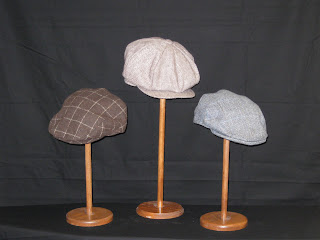 |
| 1912 |
 Any one who strikes out on the path of making a hat could risk going quite mad. The variety of styles, materials, trim and size is enough to put fear into the strongest costumer. There are many times in fashion history when not only the garment shapes are hard to see because of the trim but the hats are adorned with so many feathers, flowers, ribbon, lace, netting and hat pins it is hard to see the shape of the hat itself.
Any one who strikes out on the path of making a hat could risk going quite mad. The variety of styles, materials, trim and size is enough to put fear into the strongest costumer. There are many times in fashion history when not only the garment shapes are hard to see because of the trim but the hats are adorned with so many feathers, flowers, ribbon, lace, netting and hat pins it is hard to see the shape of the hat itself. So when it comes to fabricating a 1920's hat the first thing I looked at was the shape. Hats from this time period usually wider brims in the front than the back and the crowns are very deep.
 |
| Straw Hat Silk Trim |
 | |||
| Straw Hat Beaded Ribbon Trim |
I like hats with simple shape and trim. But this means that the hat must be cut, wired and trimmed perfectly. Wiring is the next step after cutting. I use heavy covered wire and attach it with a sewing machine on zig zag stitch. I have lost countless sewing machine needles doing this but it so much faster that trying to put it on by hand. To conceal the wire I use a length of bias made from silk, linen, velvet or a piece fabric matching the garment. The fabric that covers the wire I have tried to put on by machine but I find that putting it on by hand looks much better.
 | |||
As a rule any ribbons or fabric bows go to the back or to the left hand side. How a hat is put on matter of personal taste the one thing I do enforce is that the 1920's hats need to be worn low on the wearers head. The front of the hat should almost touch the eyebrows and the back needs to be pulled down to the nape of the neck.
This hat is worn low on the head with the trim to the left as it should be.
When I have at last finished a hat, what makes this costumer go "Mad As A Hatter" is not the mercury, but seeing it worn the wrong way.





















